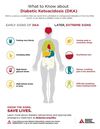Diabetic ketoacidosis Flashcards
What is diabetic ketoacidosis?
State of uncontrolled catabolism associated with insulin deficiency
Pathophysiology of ketoacidosis
Normal state: body metabolises carbs >> produces energy
Kotacidosis = alternative pathway used in states of starvation > produces acetone as a by-product
Glucose uptake is limited due to lack of insulin >> glucose remains in blood and as a result an osmotic diuresis occurs >> fluid and electrolytes are lost >> dehydration
Rapid lipolysis occurs (fat is the source of energy) this increases circulating free fatty acids which are broken down in the liver into acetyl-coA >> this is then cinverted into ketone bodies
Ketone body accumulation = acidosis >> ketones are lost in the urine and the breath
Respiratory rate increases to try and compensate for the metabolic acidosis by breathing off CO2
As dehydration worsens, the kidneys are less able to excrete ketones and H+ >> acidosis worsens
Acidosis causes increased K+ outside cells >> insulin is needed for Na/K transporter function so this further contributes to hyperkalaemia
Ketone bodies e.g. beta-hydroyxbutyrate = N&V meaning more fluid and electrolytes lost

When is ketoacidosis seen?
- Previously undiagnosed T1DM
- Interruption of insulin therapy
- Stress/ illness
- Following surgery
- MI
- Pancreatitis
- Chemo
- Antipsychotics
Clinical features of ketoacidosis
- Hyperventilation (trying to correct metabolic acidosis)
- Nausea/ vomiting
- Abdo pain
- Confusion/ stupor (if severe)
- Smell of ketones = instant diagnosis
- Dry skin (dehydration)
- Low temperature

Typical presenting feature of DKA
Drowsy, vomiting, dehydrated patient with T1DM
🥱 🤮 💦
How is DKA diagnosed?
Demonstration of hyperglycaemia + ketonaemia // heavy ketonuria + acidosis
Three things must be present:
1. Blood glucose >11mmol/L OR known diabetic
**Note a patient with DM may have a lower than expected blood glucose but still be in DKA**
2. Ketones: >3mmol/L or 2++ on dipstick
3. pH: <7.3 on blood gas OR bicarb <15mmol/L
Hyperglycaemia indicated by disptick followed by bloods sent to lab
ABG: shows low CO2, low pH
Bloods: hyponatraemia, hyperkalaemia
What is Kussmaul breathing?
🫁 Emergency response to acidosis
Deep, heavy, laboured breathing in an attempt to breathe off some CO2 to correct acidosis
What is an anion gap?
The anion gap is the difference between the number of cations versus anions - evaluates states of acidosis
If the gap is greater than normal, then high anion gap metabolic acidosis is diagnosed
What is the main electrolyte deranged in DKA?
Potassium
Management of DKA
Overall: replace fluid + electrolytes
Refer to local guidelines
Replace fluid: 0.9% saline
- Replace electrolytes: potassium given as soon as insulin given as insulin increased K+ uptake into cells
- Restore acid-base balance: a patient with healthy kidneys, once circulating volume is restored, will correct acidosis meaning bicarbonate is rarely needed (only if pH is <7.0) bicarbonate best given as an isotonic solution (1.26%)
- Replace insulin: short acting insulin given IV if monitoring is possible, if not IM every hour - subcutaneous route is avoided as patients in hypovolemic shock will have poor blood flow
- Seek underlying cause


